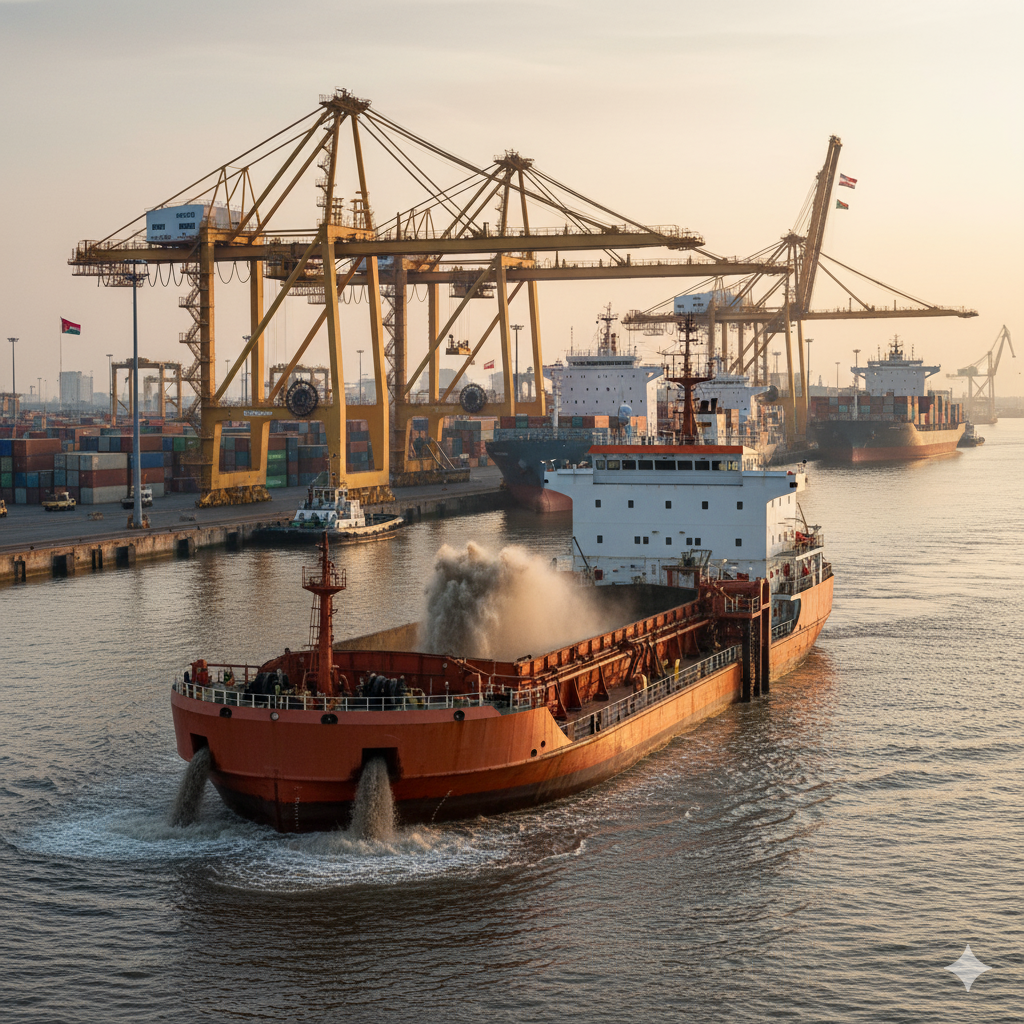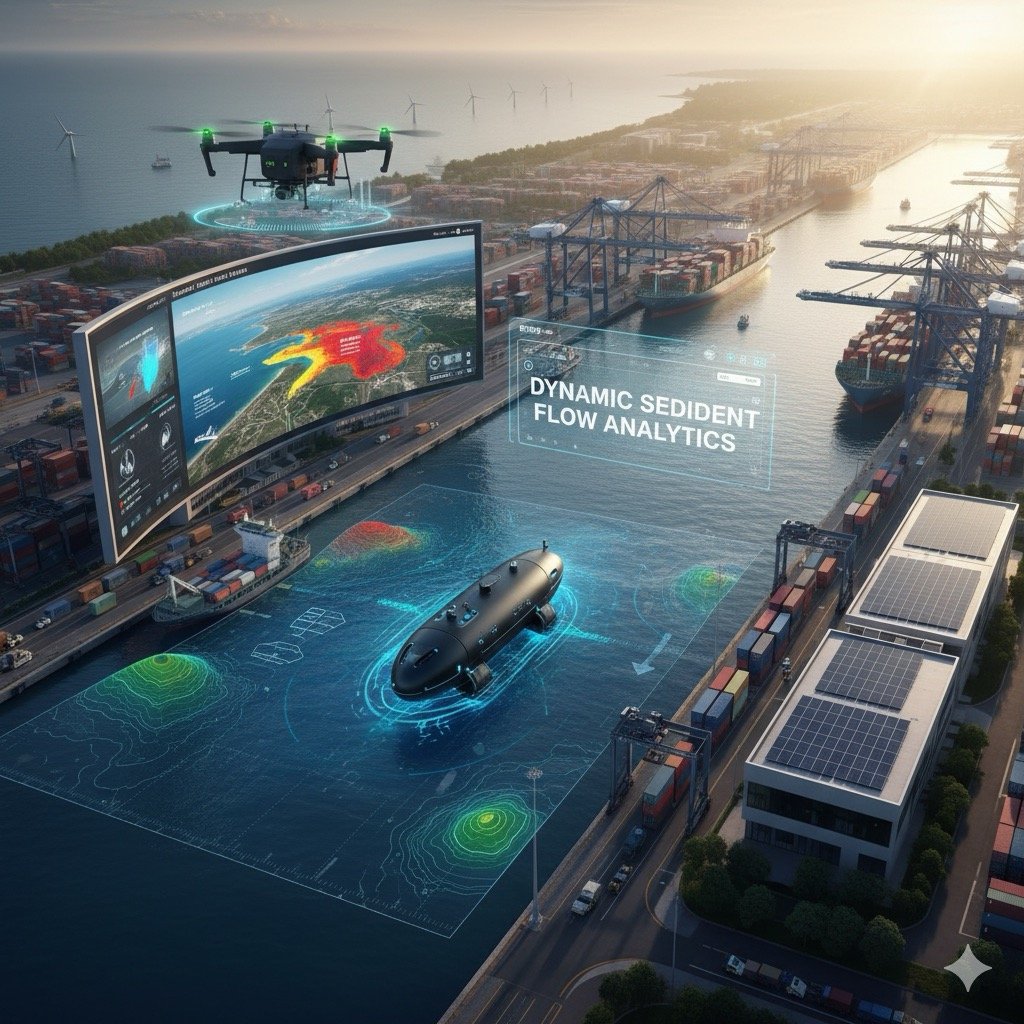- Start
- Challenges
- Sedimentation in Ports
The Muck and the Money: Understanding Sedimentation in Our Ports
Imagine a bustling port, ships gliding in and out, cranes loading and unloading cargo, a vital artery for global trade. Now imagine that artery slowly getting clogged, shallower and shallower, until only smaller vessels can enter, or worse, none at all. This isn't a doomsday scenario; it's a constant, costly challenge faced by port authorities worldwide: sedimentation.
Simply put, sedimentation is the natural process where bits of sand, silt, and mud are carried by water and settle at the bottom. In rivers, lakes, and especially coastal areas, this is a continuous cycle. But in a port, where deep channels are essential for navigation, it becomes a major headache.
In many port areas, the progressive accumulation of sediment (siltation) is reducing the operational depth of channels and docks, affecting navigation and increasing the frequency of dredging. This siltation not only represents a logistical and economic challenge, but also generates environmental impacts by altering aquatic ecosystems and increasing water turbidity. Despite current efforts, the problem persists and tends to worsen with climate change and increased maritime traffic.

Why Do Ports Get Silty? The Challenges
Think of ports as often being at the mouth of rivers or in sheltered bays. These locations, while ideal for protection from harsh seas, are also natural traps for sediment. Here's why it's such a persistent problem:
-
River Runoff: Rivers are natural sediment transporters. They pick up soil and debris from land and carry it downstream. When a river meets the slower, often tidal waters of a port, its energy drops, and it can no longer hold the sediment in suspension. Down it goes!
-
Tides and Currents: Even without rivers, tides and coastal currents constantly move sediment around. When these currents encounter the man-made structures of a port (like breakwaters or quays), their flow patterns change, creating calmer areas where sediment can settle.
-
Storms and Weather: Heavy rainfall and storms can dramatically increase the amount of sediment carried into a port. Strong winds can also stir up seabed material, contributing to the problem.
-
Dredging... and More Dredging: The traditional solution to sedimentation is dredging – literally scooping out the accumulated muck from the seabed to maintain navigation depth. While essential, it's a temporary fix because sediment continues to arrive. It's like constantly sweeping a dusty floor; the dust keeps coming!
-
Environmental Concerns: Dredging can disturb marine life, release pollutants trapped in the sediment, and be energy-intensive. Finding ways to manage sediment more sustainably is a growing priority.
-
Cost, Cost, Cost: Dredging is incredibly expensive. We're talking millions, sometimes hundreds of millions, of dollars annually for major ports. This cost ultimately impacts shipping fees and consumer prices.
The Constraints: Why It's Not a Simple Fix
Beyond the physical challenges, there are other constraints that make managing sedimentation complex:
-
Environmental Regulations: Strict rules are in place to protect marine ecosystems. Dredging operations often require extensive permits and environmental impact assessments, which can be time-consuming and costly.
-
Disposal Sites: Once dredged, the sediment has to go somewhere. Finding suitable, environmentally sound, and affordable disposal sites can be a major hurdle. Sometimes, the sediment is contaminated, making disposal even more difficult.
-
Navigational Demands: Modern cargo ships are enormous, requiring ever-deeper channels. This constant demand for depth means the fight against sedimentation is never-ending.
-
Hydrodynamic Complexity: The movement of water and sediment in a port is incredibly complex. Predicting exactly where and when sediment will accumulate requires sophisticated modeling and understanding.
Glimmers of Hope: New Technologies on the Horizon?
While dredging will likely remain a key tool, there's a strong drive to find more efficient, sustainable, and less disruptive ways to manage sediment. Here are a few areas where new technologies are emerging:
Advanced Monitoring Systems:
-
Autonomous Underwater Vehicles (AUVs) and Drones: Imagine small, robotic submarines or drones equipped with sonar and sensors. They could autonomously patrol port areas, mapping seabed levels and identifying areas of rapid sedimentation with much greater frequency and detail than traditional survey boats. This allows for more targeted and efficient dredging.
-
Satellite Imagery and AI: Analyzing satellite data, combined with artificial intelligence, could help detect changes in water turbidity and land erosion upstream, giving ports an early warning about potential increases in sediment load.
"Smart" Dredging and Sediment Re-use:
-
Precision Dredging: Instead of broad sweeps, imagine highly accurate dredgers guided by real-time data, removing only what's necessary, precisely where it's needed. This reduces fuel consumption and minimizes environmental impact.
-
Beneficial Use of Sediment: Instead of just dumping it, dredged material can be a valuable resource. Clean sediment can be used for beach nourishment (replenishing eroded coastlines), creating artificial islands for wildlife habitats, or even as construction material. Technologies that efficiently dewater and process sediment for these uses are gaining traction.
-
Mussel and Oyster Reefs: These natural filter feeders can actually improve water quality by filtering out suspended particles. Restoring or creating such reefs in strategic locations around ports could help reduce sedimentation naturally.
-
Mangrove and Saltmarsh Restoration: These coastal ecosystems act as natural barriers, slowing down water flow and trapping sediment before it reaches deeper channels. They also provide vital habitats and coastal protection. While not always feasible directly within busy port areas, they can be highly effective in adjacent zones.
-
Mussel and Oyster Reefs: These natural filter feeders can actually improve water quality by filtering out suspended particles. Restoring or creating such reefs in strategic locations around ports could help reduce sedimentation naturally.
-
Mangrove and Saltmarsh Restoration: These coastal ecosystems act as natural barriers, slowing down water flow and trapping sediment before it reaches deeper channels. They also provide vital habitats and coastal protection. While not always feasible directly within busy port areas, they can be highly effective in adjacent zones.
Innovative Sediment Trapping and Removal:
-
Sediment Traps/Pits: Designing specific areas within a port to intentionally collect sediment, making it easier and more cost-effective to remove.
-
Fluidisation Technologies: Some experimental methods use jets of water to "fluidise" the top layer of sediment, allowing it to be carried away by currents to deeper, less critical areas, or to collection points, without traditional mechanical dredging.

Integration: Making it Happen
The key to adopting new technologies lies in their ease of integration. Many of these emerging solutions are "data-driven." This means they can often be integrated with existing port management systems, leveraging sensors, communication networks, and data analytics platforms that ports are increasingly adopting for other operations.
For example, data from AUVs can feed directly into dredging scheduling software. Information from satellite imagery can inform long-term port planning. Nature-based solutions, while requiring upfront planning, can reduce the need for constant mechanical intervention, fitting into broader sustainability goals.
The Future is Clearer (and Deeper)
Sedimentation will always be a natural process, but how we manage it is evolving. By embracing smart monitoring, precision interventions, beneficial re-use of materials, and working with nature, ports can become more resilient, more sustainable, and continue to serve as the vital gateways of global commerce for years to come. The goal is to move from a reactive "dig and dump" approach to a proactive, integrated, and environmentally conscious strategy for keeping our waterways clear.

